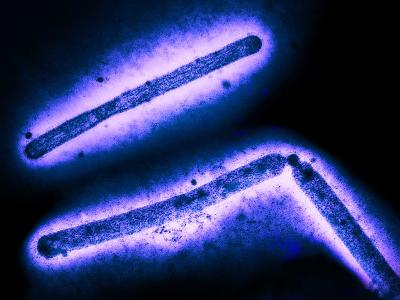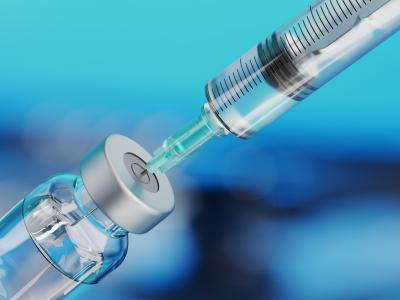Study notes lower immune response after 2 straight flu vaccinations
Post-vaccine levels of antibodies to influenza hemagglutinin (HA) and neuraminidase (NA) decline slowly over 18 months in adults, and individuals vaccinated 2 years in a row have significantly lower immune responses, according to a study yesterday in the Journal of Infectious Diseases.
University of Michigan researchers analyzed data from 941 adults 18 to 49 years old who participated in the second and third years of a previously published randomized controlled trial conducted during the 2005-06 and 2006-07 flu seasons on the efficacy of trivalent inactivated vaccine (TIV) and live-attenuated influenza vaccine (LAIV). They examined blood specimens taken just before vaccination and at 1, 6, 12, and 18 months after vaccination.
They found that HA inhibition (HAI) and NA inhibition (NAI) titers decreased slowly and minimally over 18 months and estimated it would take on average about 600 days (20 months) for a two-fold antibody titer decrease. The rate of decline was faster in TIV recipients, but those recipients achieved much higher post-vaccination HAI and NAI titers. And titers of TIV recipients remained significantly higher than LAIV recipients or placebo recipients after 18 months.
The investigators also found that both TIV and LAIV recipients vaccinated 2 consecutive years had significantly lower HAI titers following vaccination in the second year, although the rates of antibody decline were similar to those not vaccinated 2 years running.
The authors conclude that, even though antibodies remain high over multiple seasons, antigenic drift of circulating strains may necessitate annual vaccination. They add that, even though HAI response to immunization may be impaired with back-to-back vaccinations, it is still higher than with a placebo, even after 18 months.
They also write, "Given the longevity of NAI titers observed here, improving vaccine-induced response to NA might increase the practical duration of protection when HA drifts and NA does not." And they sum up: "These results point to the need for vaccines that stimulate a greater breadth of immunity to achieve better and longer lasting protective efficacy."
May 26 J Infect Dis abstract
Listeria contamination found on surfaces at Bidart Bros. California facility
The source of contamination in last year's 12-state Listeria outbreak linked to prepackaged caramel apples may well have been the cooler and packing house at Bidart Bros., the California apple producer that has been under investigation, reports a story today in Food Safety News (FSN).
Inspectors, including officials from the Food and Drug Administration (FDA) and the California Department of Public Health, carried out four on-site inspections from Dec 23, 2014, to Jan 6 of this year at Bidart's Shafter, Calif., facility.
Samples were collected from food and non-food contact surfaces in packing and cold storage areas as well as from outside storage bins. Samples in seven areas were positive for Listeria, with six of those involving surfaces with which apples had direct contact during the 2014 growing season, according to the story. It says the evidence is included on FDA 483 forms filled out after the investigations and a "mostly public 16-page report."
Among specific problem areas identified during inspections were packaging equipment that could not be "properly cleaned and sanitized," a damaged conveyor belt, frayed vinyl coating on a transfer chute, and a damaged bucket conveyer.
Bidart Bros., a well-known agricultural company that reportedly has been "very cooperative" during the investigation, voluntarily recalled all Granny Smith and Gala apples processed at its cooler-packing facility after the Jan 6 inspection; several distributors of caramel apples had recalled their products prior to that.
The outbreak sickened 35 people in 12 states, 31 of whom had eaten caramel apples. Seven people died, with three of those cases tied directly to listeriosis.
May 27 FSN story
Feb 13 FDA information page on outbreak
Europe reports 3,800 measles cases, 4,400 rubella cases in past year
European Union (EU) and European Economic Area (EEA) countries saw 3,809 cases of measles and 4,394 cases of rubella from April of last year through March of this year, with 1 measles case proving fatal and 6 complicated by acute encephalitis, says a new quarterly report from the European Centre for Disease Prevention and Control (ECDC).
Thirty EU/EEA countries had measles cases (70.1% of them laboratory confirmed), with 69.9% of the cases in Germany and Italy, says the report. An outbreak in Berlin that began last October continues, with cases through Apr 22 numbering 1,134.
Vaccination status was known in 3,365 measles case-patients (88.3%); 2,742 of these (81.5%) had not been vaccinated, says the report.
The report states that measles outbreaks outside of Europe are ongoing in Mongolia, the Republic of Congo, Guinea, Liberia, Sudan, and Brazil.
Rubella has occurred in 27 EU/EEA countries over the same period, with 96% of cases occurring in Poland. The report states that 32% of case-patients were unvaccinated, noting that fewer than 1% of cases were laboratory confirmed.
"ECDC closely monitors progress towards interruption of endemic transmission of both diseases through enhanced surveillance and epidemic intelligence," while working toward a goal of eradication of both diseases in 2015, says an ECDC press release.
May 27 ECDC press release
April Measles and Rubella Monitoring Report
Tiny chip shows promise for 1-hour antibiotic-resistance detection
University of Toronto scientists have developed a test for flagging antibiotic-resistant bacteria in 1 hour instead of the usual 2 to 3 days, according to their paper in the journal Lab on a Chip.
The team designed a tiny chip that concentrates bacteria in a minuscule space to increase the effective concentration of the sample, according to a University of Toronto news release yesterday. The chip contains nano-sized wells that trap bacteria as the sample flows across its surface. The wells harbor antibiotics and a signal molecule called resazurin.
Bacteria metabolize resazurin into a form called resorufin, changing its electrochemical signature. If the bacteria are killed by the antibiotic, they stop metabolizing resazurin. If they are antibiotic-resistant, however, they continue to metabolize resazurin into resorufin, altering the electrochemical signature, which is then detected by the chip.
"Our approach is the first to combine this method of increasing sample concentration with a straightforward electrochemical readout," said coauthor Edward H. Sargent, PhD, vice-dean of research for applied science and engineering at the University of Toronto. "We see this as an effective tool for faster diagnosis and treatment of commonplace bacterial infections."
The authors conclude, "This electrochemical phenotyping approach is effective with clinically-relevant levels of bacteria, and provides results comparable to culture-based analysis. Results, however, are delivered on a much faster timescale, with resistance profiles available after a one hour incubation period."
May 13 Lab Chip abstract
May 26 University of Toronto news release















